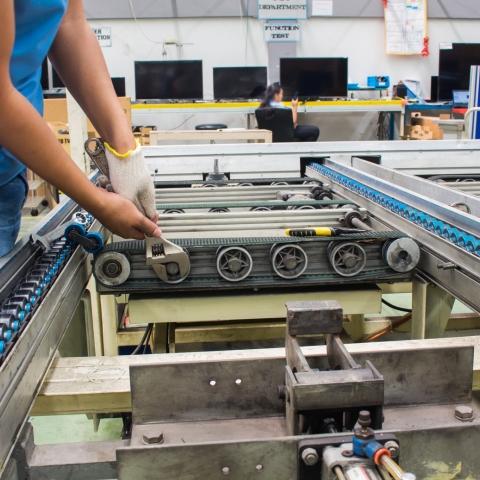A lathe is a versatile machine tool used in machining operations to shape, cut, or drill various materials into cylindrical shapes. Understanding the essential lathe parts and their functions is crucial for anyone involved in machining processes. In this guide, we will provide an in-depth overview of the key components of a lathe and explain their roles in the machining process. 1. Bed: The bed is the foundation of the lathe and serves as a rigid, horizontal base. It provides stability and support to all other lathe components. The bed must be precisely machined to ensure accuracy in the workpiece. 2. Headstock: The headstock is positioned at the left end of the lathe's bed and contains the spindle. It houses the driving mechanism, such as gears and belts, which transfer power from the motor to the spindle. The headstock also holds various spindle accessories, such as chucks and faceplates. 3. Spindle: The spindle is a rotating shaft that extends from the headstock. It holds the workpiece securely and rotates it at a controlled speed. Various attachments, such as collets and chucks, are used to grip different types of workpieces on the spindle. 4. Tailstock: Located at the right end of the lathe's bed, the tailstock serves as a support for the other end of the workpiece. It can be moved along the bed to accommodate workpieces of different lengths. The tailstock often includes a quill, which can be extended or retracted to apply pressure or support to the workpiece. 5. Carriage: The carriage is mounted on the bed and can move along the length of the lathe. It houses the cutting tool and tool post. The carriage's movement is controlled by the cross-slide and leadscrew, allowing precise positioning of the cutting tool. 6. Cross-Slide: The cross-slide is mounted on the carriage and allows for movement perpendicular to the lathe's axis. It is used for making precise crosswise cuts and turning operations. 7. Leadscrew: The leadscrew is a threaded rod that runs along the length of the bed. It is connected to the carriage and allows for precise longitudinal movement, enabling the turning of long workpieces. 8. Tool Post: The tool post is mounted on the carriage and holds the cutting tool securely. It can be adjusted to various angles and positions to perform different machining operations. 9. Compound Rest: The compound rest is mounted on the carriage and provides additional support and control over the cutting tool's movement. It can be swiveled to allow for angled cuts. 10. Chuck: A chuck is a gripping device attached to the spindle. It holds the workpiece securely during machining operations. Different types of chucks, such as three-jaw chucks and four-jaw chucks, are used based on the requirements of the workpiece. Conclusion: Understanding the various lathe parts and their functions is essential for effectively using a lathe machine in machining operations. Whether you are a novice or an experienced machinist, having a thorough knowledge of these components will enable you to produce accurate and precise workpieces while ensuring the safety of the machining process.
Search
Categories
- Advertising
- Affiliate Programs
- Animals
- Art
- Auctions
- Back Links
- Business
- Causes
- Computer Repair's
- Computers
- Control Panels All
- Cooking
- Crafts
- Dance
- Dating
- DIY
- Drinks
- Economics
- Editing Websites
- Education
- Electronics
- Entertainment
- Everything Else
- Family
- Film
- First Vita Plus
- Fitness
- Food
- Freelancers
- Gadgets
- Games
- Gardening
- Health
- Healthy Vitamins
- Herbalife
- History
- Home
- Home Schooling
- Hosting
- How to Guide
- Life Style
- Link Building
- Literature
- Movies
- Music
- Networking
- News
- Party
- Pets
- Photography
- Politics
- Recipe
- Recreation
- Religion
- Romance
- SEO/ SMM /SEM
- Servers
- Shopping
- Skilled Trade
- Society
- Software
- Sports
- Technical Support
- Technology
- Theater
- Torrent Sites
- Travel
- TV Shows
- Watkins
- Web Design
- Websites
- Websites for Sale
- Wellness
- World News
Read More
Copper Foil Market Global Sales, Price, Revenue, Gross Margin and Market Share 2028
The latest Copper Foil Market study offers an all-inclusive analysis of the major...
Webagentur Bern | mit Webtrics ein Partner von A-Z
Webagentur Bern | für KMU im Kanton Bern bieten wir individuelle Weblösungen.
Knee Pads Market Industry Analysis and Forecast 2028
The Knee Pads Market is expected to be growing at a growth rate of 4.8% in the...
Unable to view transactions on blockchain after Coinbase Pro log in
Currently every person is talking about cryptocurrency and in this one of the most common that...
Transforming Transactions: Embrace Cryptocurrency with KUNA Pay
In the digital age, businesses must evolve to meet the dynamic needs of consumers. KUNA Pay...
© 2024 DJJ Meets Say & Post Anything You Want To  English
English


